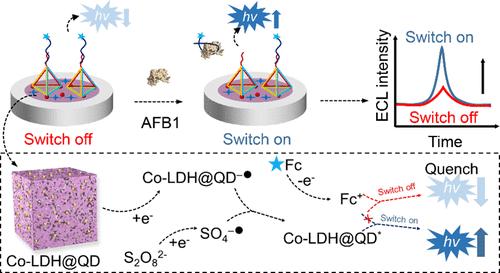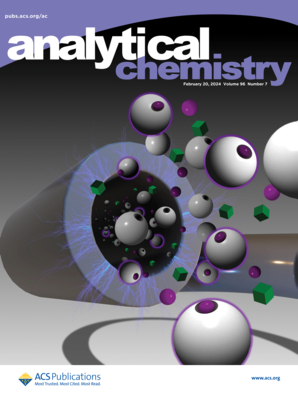Switch-Type Electrochemiluminescence Aptasensor for AFB1 Detection Based on CoS Quantum Dots Encapsulated in Co-LDH and a Ferrocene Quencher
IF 6.7
1区 化学
Q1 CHEMISTRY, ANALYTICAL
引用次数: 0
Abstract
Among the various aflatoxin B1 (AFB1) assays, performing accurate detection is difficult because false positives and false negatives are frequent due to limited sensitivity, expensive equipment, or inadequate pretreatment during operation. Here, an “off–on” switch-type electrochemiluminescence (ECL) aptasensor armed with cobalt–sulfur quantum dots was encapsulated in hollow cobalt-layered double hydroxide nanocages as an enhanced luminescent probe (Co-LDH@QDs), and a ferrocene-modified aptamer (Fc-APT) was used as a luminescent quencher. In general, when Fc-APT was hybridized with complementary DNA modified with a DNA nanotetrahedron, electron transfer between ferrocene and Co-LDH@QDs was facilitated, leading to efficient quenching of the ECL intensity into an “off” state in the absence of AFB1. In the presence of AFB1, the intensity of ECL increased with an increasing AFB1 concentration after Fc-APT specifically recognized that AFB1 was detached from the electrode interface to achieve an “on” state. The linear range of the proposed ECL aptasensor for AFB1 detection was 0.1 pg mL–1 to 10 ng mL–1, with a detection limit of 0.03 pg mL–1. We successfully employed the proposed ECL aptasensor for corn application, which provides an economical and simple alternative to complex and costly enzyme-linked immunoassays. The switch-type ECL aptasensor provides quick, accurate, and prospective technological support for pinpoint management of food safety.

基于Co-LDH包封的CoS量子点和二茂铁猝灭剂的AFB1检测开关型电化学发光传感器
在各种黄曲霉毒素B1 (AFB1)检测中,由于灵敏度有限、设备昂贵或操作过程中预处理不足,假阳性和假阴性频繁发生,因此很难进行准确检测。本研究将一种带有钴硫量子点的开关型电化学发光(ECL)适体传感器封装在空心钴层双氢氧化物纳米笼中作为增强发光探针(Co-LDH@QDs),并使用二茂铁修饰的适体(Fc-APT)作为发光猝灭剂。总的来说,当Fc-APT与DNA纳米四面体修饰的互补DNA杂交时,促进了二茂铁和Co-LDH@QDs之间的电子转移,从而在没有AFB1的情况下有效地将ECL强度猝灭为“关闭”状态。在AFB1存在的情况下,Fc-APT特异性识别AFB1与电极界面分离达到“on”状态后,ECL的强度随着AFB1浓度的增加而增加。ECL检测AFB1的线性范围为0.1 pg mL-1 ~ 10 ng mL-1,检出限为0.03 pg mL-1。我们成功地将所提出的ECL配体传感器应用于玉米,它为复杂和昂贵的酶联免疫测定提供了一种经济简单的替代方法。开关型ECL感应传感器为食品安全的精确管理提供了快速、准确和前瞻性的技术支持。
本文章由计算机程序翻译,如有差异,请以英文原文为准。
求助全文
约1分钟内获得全文
求助全文
来源期刊

Analytical Chemistry
化学-分析化学
CiteScore
12.10
自引率
12.20%
发文量
1949
审稿时长
1.4 months
期刊介绍:
Analytical Chemistry, a peer-reviewed research journal, focuses on disseminating new and original knowledge across all branches of analytical chemistry. Fundamental articles may explore general principles of chemical measurement science and need not directly address existing or potential analytical methodology. They can be entirely theoretical or report experimental results. Contributions may cover various phases of analytical operations, including sampling, bioanalysis, electrochemistry, mass spectrometry, microscale and nanoscale systems, environmental analysis, separations, spectroscopy, chemical reactions and selectivity, instrumentation, imaging, surface analysis, and data processing. Papers discussing known analytical methods should present a significant, original application of the method, a notable improvement, or results on an important analyte.
 求助内容:
求助内容: 应助结果提醒方式:
应助结果提醒方式:


